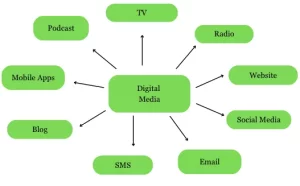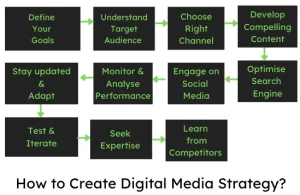How to Create a Digital Media Strategy That Gets Results?
In today’s fast-paced, interconnected world, a robust digital media strategy is no longer a luxury but a necessity for businesses. With the rise of the use of the internet and social media, how audiences consume information, connect with your brand, and make purchase decisions has drastically changed.
This is why having a digital media strategy to attract an audience for higher engagement is a must.
From increasing brand awareness to engaging with your target audience, let’s uncover the immense power and potential of a well-crafted digital media strategy.
“It’s not what you sell that matters as much as how you sell it!”- Brian Halligan
What is digital media strategy?
A digital media strategy is a comprehensive plan outlining how individuals or businesses will leverage various digital channels and platforms to achieve specific goals and objectives.

- It involves strategizing and implementing online marketing tactics, content creation and distribution, social media engagement, and other digital activities to effectively reach and engage with the target audience.
- A well-crafted digital media strategy considers target audience demographics, market research, competition analysis, and brand positioning.
- It aims to maximise the impact of digital media by utilising the most appropriate channels, content formats, and marketing techniques that align with the overall business objectives.
- Digital media strategies can include search engine optimization (SEO), social media marketing, email marketing, content marketing, paid advertising, influencer collaborations, and website optimization.
- The strategy may involve setting specific goals, defining key performance indicators (KPIs), creating a content calendar, and continuously monitoring and analysing performance to make data-driven improvements.
Read: What is digital media strategy?Types and importance.
How to create a digital media strategy that gets results?
Creating a strategy for marketing on social media that gets results requires careful planning and execution. Here are some steps to help you make a practical system:
Define Your Goals
Clearly identify your objectives and what you want to achieve through your digital media efforts. Whether it’s increasing brand awareness, driving website traffic, generating leads, or boosting sales, defining your goals will guide your strategy.
Understand Your Target Audience:
Conduct thorough market research to gain insights into your target audience’s demographics, interests, behaviours, and online preferences. This knowledge will help you tailor your content, messaging, and channel selection to effectively reach and engage with your audience.
Choose the Right Digital Channels:
Based on your target audience research, select the digital channels that align with their preferences and your goals. This may include social media platforms, email marketing, content marketing, paid advertising, or a combination thereof. Focus on quality over quantity and prioritise channels that provide the best opportunities to connect with your audience.
Develop Compelling Content:
Create a content strategy that resonates with your audience and supports your goals. Develop high-quality, relevant, and valuable content that addresses their needs, pain points, and interests. Consider different content formats such as blog posts, videos, infographics, podcasts, or interactive content to cater to other preferences.
Optimise for Search Engines:
Implement search engine optimization (SEO) techniques to improve your website’s visibility in search engine results. Conduct keyword research, optimise your website structure and content, and ensure your site is mobile-friendly. This will help increase organic traffic and improve your chances of being found by your target audience.
Engage on Social Media:
Establish a strong presence on social media platforms relevant to your audience. Develop a social media strategy that includes consistent posting, engaging with followers, responding to comments, and fostering conversations. Leverage social media advertising and influencer collaborations to extend your reach and engage with a broader audience.
Monitor and Analyze Performance:
Set up analytics tools to track key performance indicators (KPIs) aligned with your goals. Monitor website traffic, engagement, conversion rates, and ROI metrics. Analyse the data to gain insights into what’s working and needs improvement. Use these insights to refine your strategy and make data-driven decisions.
Stay Updated and Adapt:
The digital landscape evolves rapidly, so it’s crucial to stay updated on the latest trends, technologies, and best practices. Regularly assess and adapt your strategy to incorporate new opportunities and address changes in consumer behaviour or platform algorithms.
Test and Iterate:
Continuously test different approaches, content formats, messaging, and targeting to optimise your strategy. Use A/B testing to compare variations and determine what resonates best with your audience. Learn from your results and iterate your strategy accordingly.
Seek Expertise and Learn from Competitors:
If needed, consider consulting with digital marketing professionals or agencies who can provide valuable insights and expertise. Additionally, study and learn from your competitors’ digital media strategies to understand what is working in your industry and adapt relevant tactics to your own strategy.
Tools of Digital Marketing
There are numerous tools available in the field of digital marketing that can help marketers and businesses streamline their efforts and achieve better results.
Here are some commonly used tools:
- Content Management Systems (CMS): Platforms like WordPress, Drupal, or Joomla provide a user-friendly interface to create, manage, and publish content on websites or blogs.
- Social Media Management Tools: Tools like Hootsuite, Buffer, and Sprout Social help schedule and manage social media posts, track engagement, and analyse performance across multiple platforms.
- Email Marketing Software: Mailchimp, Constant Contact, and Sendinblue allow businesses to create and send targeted email campaigns, manage subscriber lists, and track email performance metrics.
- Search Engine Optimization (SEO) Tools: Tools like SEMrush, Moz, and Ahrefs help analyse website performance, conduct keyword research, monitor search engine rankings, and optimise web pages for better visibility in search results.
- Analytics Tools: Google Analytics is widely used for tracking website traffic, user behaviour, conversions, and other vital metrics. It provides valuable insights for making data-driven decisions.
- Pay-Per-Click (PPC) Advertising Platforms: Google Ads and Bing Ads are popular platforms for running paid search advertising campaigns, reaching a targeted audience, and measuring ad performance.
- Social Media Advertising Platforms: Facebook Ads, Instagram Ads, and Twitter Ads enable businesses to create targeted ad campaigns and reach specific demographics based on user interests, demographics, and behaviours.
- Content Creation and Design Tools: Tools like Canva, Adobe Creative Cloud, or Piktochart help create visually appealing graphics, infographics, and other types of content.
- Customer Relationship Management (CRM) Software: Platforms like Salesforce, HubSpot, and Zoho CRM help manage customer data, track leads, automate marketing workflows, and facilitate customer engagement.
- A/B Testing Tools: Tools like Optimizely, Google Optimise, or VWO enable marketers to test different variations of web pages, emails, or ad campaigns to identify the most effective versions for better conversion rates.
Conclusion
The digital landscape is constantly evolving, and being agile and proactive will help you stay ahead of the competition.
Creating a digital media strategy that gets results is dynamic and iterative. Following the steps outlined in this blog, you can develop an effective method to maximise your brand’s online presence, engage with your target audience, and achieve your business objectives.
It’s essential to stay updated with the latest digital trends and adapt your strategy accordingly. With a well-crafted digital media strategy in place, you can unlock the true potential of your online presence, connect with your audience, and achieve measurable results. If you want to embrace digital opportunities, and embark on your journey towards digital success, contact us.
FAQ
How can I determine which digital media channels are most effective for my business? Choosing your business’s most compelling digital media channels involves understanding your target audience and their online behaviours. Conduct market research and analyse data to identify where your audience spends online. Consider demographics, interests, and platform usage statistics to decide which channels will best reach and engage your target audience.
How often should I review and update my digital media strategy?
Regularly reviewing and updating your digital media strategy is essential to stay relevant in the dynamic digital landscape. Set a schedule for periodic strategy reviews, considering factors such as market trends, changes in consumer behaviour, and the performance of your current digital campaigns. Be open to adapting your strategy as needed to ensure it aligns with your business goals and continues to effectively reach and engage your target audience.
How can I measure the success of my digital media strategy?
Measuring the success of your digital media strategy involves tracking key performance indicators (KPIs) that align with your objectives. These can include website traffic, conversion rates, engagement on social media, click-through rates, and ROI from digital advertising. Utilise analytics tools, campaign tracking codes, and social media insights to gather data and evaluate the performance of your digital media efforts. Regularly analyse this data to gain insights and make informed decisions for optimising your strategy.
Also Read – The Ultimate Guide to Marketing Strategies & How to Improve Your Digital Presence



